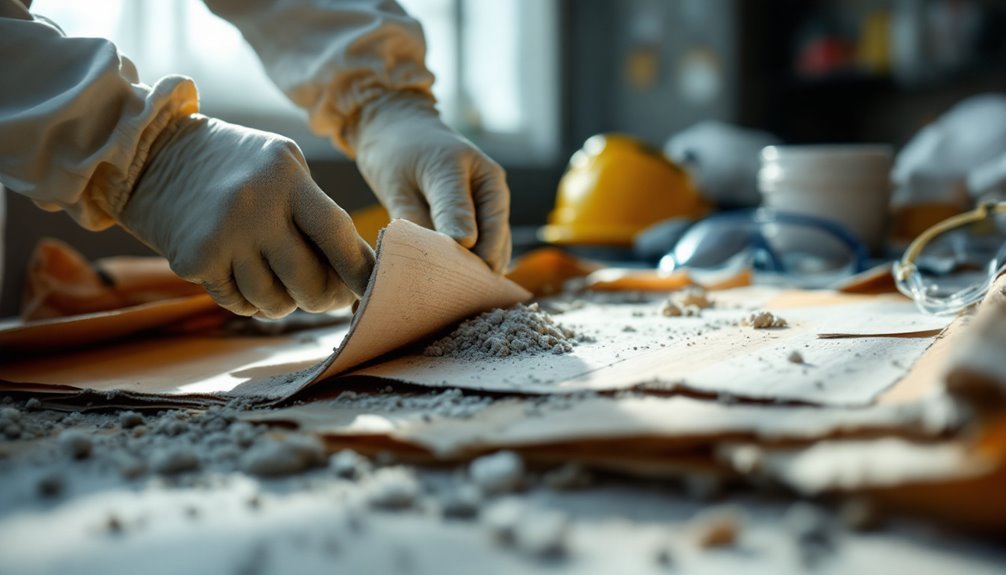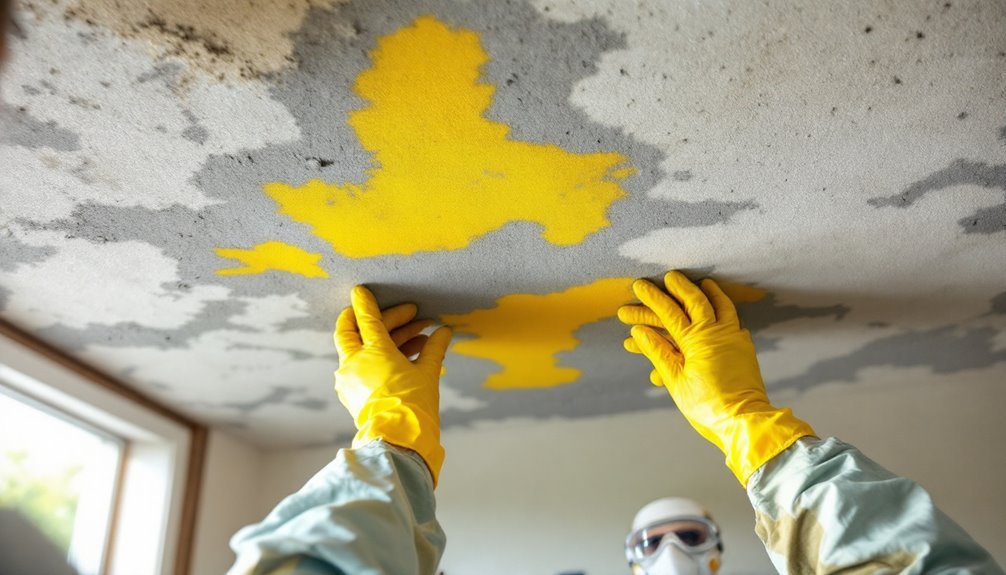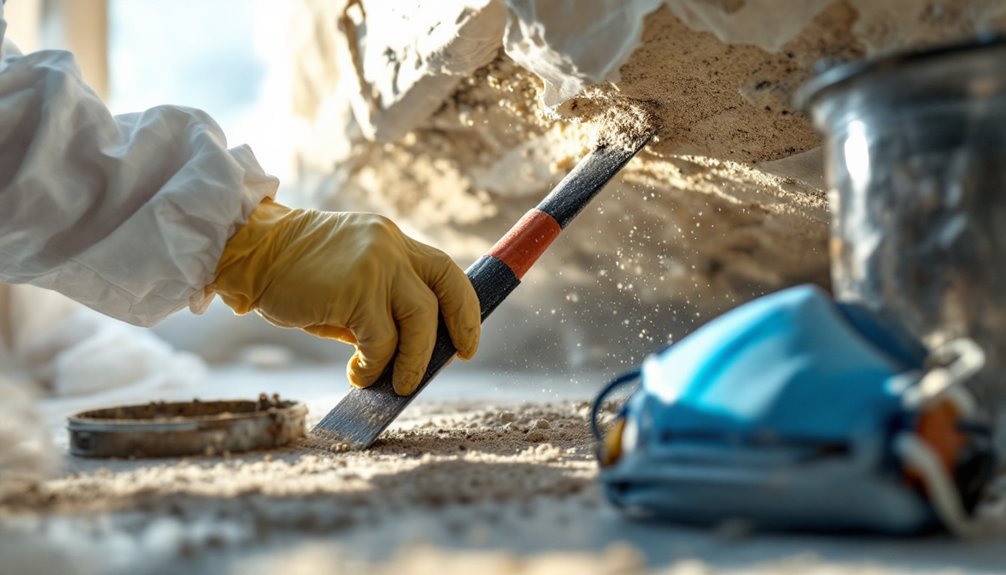Understanding asbestos is crucial for keeping your home safe. This hazardous material, often found in older insulation, flooring, and ceilings, poses serious health risks, including lung cancer and asbestosis. If your home was built before the 1980s, you should inspect for asbestos using professional testing services. Safe removal requires personal protective equipment, careful isolation of the work area, and adherence to local disposal regulations. Always hire qualified contractors with proper certifications to guarantee compliance. After removal, thorough cleaning and air quality tests are imperative for safety. There's more to learn about effective practices and legal guidelines to secure your safety.
What Is Asbestos?

Asbestos is a naturally occurring mineral composed of thin, fibrous crystals that can be found in various geological formations around the world. Its unique properties, such as resistance to heat and chemical damage, have made it a popular material in construction and manufacturing. There are several asbestos types, including chrysotile, amosite, and crocidolite, each with distinct characteristics and applications. Chrysotile, commonly known as white asbestos, is the most widely used, while amosite and crocidolite are often found in insulation materials.
Asbestos history dates back thousands of years, with evidence of its use in ancient civilizations for textiles and building materials. Nevertheless, its popularity surged during the industrial revolution, leading to its incorporation into numerous products, including roofing, flooring, and fireproofing materials. This widespread use continued until the late 20th century, when the harmful effects of asbestos exposure became more widely recognized.
Understanding what asbestos is, including its types and historical usage, is critical for homeowners and renovators. By being informed, you can make educated decisions about managing asbestos in your environment and guarantee your living space remains safe.
Health Risks of Asbestos
Exposure to asbestos can lead to severe health complications, making awareness of its risks imperative. When you inhale asbestos fibers, they can become trapped in your lungs, leading to significant lung diseases. One of the most serious conditions is asbestosis, a chronic lung disease that causes scarring of lung tissue, resulting in difficulty breathing and reduced lung capacity. Furthermore, asbestos exposure is a known risk factor for lung cancer, particularly among smokers.
Another grave health concern is mesothelioma, a rare but aggressive cancer linked directly to asbestos exposure. This disease primarily affects the lining of the lungs and abdomen, often presenting symptoms only decades after exposure.
It's important to understand that even low levels of asbestos exposure can be harmful over time. The risks aren't limited to direct exposure; secondary exposure can occur when fibers are carried on clothing or hair, putting loved ones at risk.
Proactive measures, such as regular air quality testing and professional inspections, are necessary for maintaining a safe living environment. By recognizing the health risks associated with asbestos, you empower yourself to take necessary actions to protect your health and well-being.
Identifying Asbestos in Your Home

To identify asbestos in your home, start by checking common locations such as insulation, ceiling tiles, and flooring materials. You can use visual identification techniques to spot potential asbestos-containing materials, but remember that these methods aren't foolproof. For a definitive assessment, consider hiring professional services that specialize in asbestos testing and removal.
Common Asbestos Locations
Identifying asbestos in your home can be fundamental for maintaining a safe living environment. You'll want to be aware of common locations where asbestos may be found. One significant area is the basement, particularly in insulation materials. Many homes built before the 1980s used asbestos-containing products for thermal insulation on pipes and ductwork. If you've got a basement, inspect any insulation closely.
Another common location is ceiling tiles. Asbestos was frequently used in older ceiling tiles for its fire-resistant properties and durability. If your home has ceiling tiles that were installed prior to the 1980s, it's imperative to verify whether they contain asbestos.
Moreover, check around furnaces, boilers, and walls adjacent to these heating systems, as insulation and other materials in these areas may likewise contain asbestos.
If you suspect asbestos in these locations, it's best to consult with a professional for testing and potential removal. Keeping your home free of asbestos is critical for your health and safety, allowing you the freedom to enjoy your living space without the worry of harmful exposure.
Visual Identification Techniques
A thorough visual inspection can often reveal signs of asbestos in your home. Understanding the visual cues associated with asbestos-containing materials (ACMs) is vital for your safety. Familiarize yourself with common inspection methods to identify these materials effectively.
Here's a handy reference table to guide your inspection:
| Material Type | Visual Cues |
|---|---|
| Insulation | Dark, fibrous material, often crumbling |
| Floor Tiles | Vinyl tiles that may have a speckled appearance |
| Ceiling Tiles | Textured surfaces that resemble popcorn or spray |
| Pipe Insulation | Wrapped with thick, fuzzy material, often white |
| Roofing Materials | Corrugated sheets with a fibrous texture |
When you conduct your inspection, look for frayed edges, discoloration, or any signs of damage. Keep an eye out for areas that seem unusual or inconsistent with the rest of your home. If you suspect any materials might contain asbestos, it's necessary to take immediate precautions before proceeding with any removal. Remember, identifying asbestos visually is the first step in protecting your home and your health.
Professional Assessment Services
After conducting a visual inspection, the next step involves engaging professional assessment services to verify the presence of asbestos in your home. These experts utilize advanced assessment methods to guarantee accurate identification. Relying on their expertise is vital, as asbestos can be hidden in various materials, including insulation, tiles, and roofing.
During asbestos testing, professionals will collect samples from potential asbestos-containing materials (ACMs). They typically use methods like polarized light microscopy (PLM) and transmission electron microscopy (TEM) to analyze the samples in a lab setting. These techniques allow for precise detection of asbestos fibers, determining both the type and concentration present.
It's fundamental to choose a certified service provider, as they adhere to strict safety protocols and regulations. They'll not only identify asbestos but additionally provide guidance on safe management or removal options. By opting for professional assessment services, you're taking a proactive step towards guaranteeing your home's safety and protecting your freedom from potential health risks associated with asbestos exposure. Remember, timely action can prevent further complications, so don't hesitate to seek professional help.
Legal Regulations and Guidelines
Maneuvering through the legal environment surrounding asbestos removal is crucial for anyone involved in renovation or demolition projects. Understanding the compliance requirements and potential legal liabilities can help you avoid costly penalties and health hazards. Here are four critical points to take into account:
- Federal Regulations: Familiarize yourself with the Environmental Protection Agency (EPA) guidelines, which dictate safe handling and disposal of asbestos materials.
- State Laws: Each state may have additional regulations that complement federal laws. Check with your local environmental agency for specifics.
- Notification Requirements: Before starting any removal, you might need to notify local authorities or agencies about your project, especially if it involves significant disturbance of asbestos-containing materials.
- Hiring Certified Professionals: Always employ licensed asbestos abatement contractors who comply with both federal and state regulations. This not only guarantees safety but likewise mitigates your legal liabilities.
Safe Asbestos Removal Practices

Understanding safe asbestos removal practices is essential for protecting both your health and the environment during renovation or demolition projects. First, make sure you wear the appropriate personal protective equipment (PPE), including respirators, gloves, and coveralls. This gear minimizes your exposure to asbestos fibers, making safe handling a priority.
Next, isolate the work area. Seal off any doors and windows to prevent the spread of dust and fibers. Use plastic sheeting to encapsulate the area, and employ a HEPA vacuum for cleanup. Wetting asbestos materials before removal can likewise help reduce airborne fibers, making the process safer.
When it comes to proper disposal, follow local regulations. Place the removed asbestos materials in sealed, labeled containers specifically designed for hazardous waste. Transport these containers to a licensed disposal facility. Never throw asbestos waste in regular trash, as this poses significant health risks.
Lastly, keep a thorough record of the removal process, including safety measures taken and disposal receipts. By adhering to these practices, you guarantee not only your safety but also that of others and the environment around you.
Hiring Professional Asbestos Contractors
When it comes to asbestos removal, hiring professional contractors is crucial for guaranteeing safety and compliance with regulations. Attempting to handle asbestos on your own can lead to serious health risks and legal issues. To make a knowledgeable choice, consider the following factors:
- Contractor Qualifications: Verify that the contractor holds the necessary licenses and certifications specific to asbestos removal. This includes training in handling hazardous materials safely.
- Experience: Look for contractors with proven experience in asbestos abatement projects. Their expertise will guarantee proper techniques and protocols are followed.
- Insurance and Bonding: Confirm the contractor has liability insurance and is bonded. This protects you from potential financial liability if accidents occur during the removal process.
- Cost Considerations: While it may be tempting to choose the lowest bid, consider the overall value. Cheaper options might compromise safety or quality. Get multiple quotes to gauge the average cost while confirming the contractor meets all safety and regulatory standards.
Post-Removal Safety Tips

After the asbestos removal process is complete, it's vital to prioritize safety to guarantee that your environment remains free from any residual hazards. Start with thorough cleaning; verify that all areas where asbestos was present are vacuumed using a HEPA-filtered vacuum to capture any remaining fibers.
Implement post removal precautions by sealing any disturbed areas with high-quality sealants. This helps prevent any airborne particles from escaping. It's also prudent to conduct air quality tests after the removal to confirm that the air is clear and safe to breathe.
Long term monitoring is important. Schedule regular inspections and air quality assessments to verify that no new asbestos issues arise in the future. Keep an eye on any areas that were previously affected, as deterioration can occur over time.
Educate everyone in your household about the signs of potential asbestos exposure and the significance of reporting any suspicious materials. By taking these proactive steps, you can maintain a safe and healthy living environment, allowing you to enjoy your home with peace of mind.
Conclusion
In the end, it's ironic how something once hailed for its durability now poses such a significant threat to your health. By understanding asbestos, its risks, and the safe removal practices, you're not just protecting your home; you're safeguarding your future. Remember, hiring professionals isn't just a suggestion—it's crucial. So, while the process may feel intimidating, prioritizing safety guarantees that your living space becomes a sanctuary, free from the very materials that were once deemed "safe."
